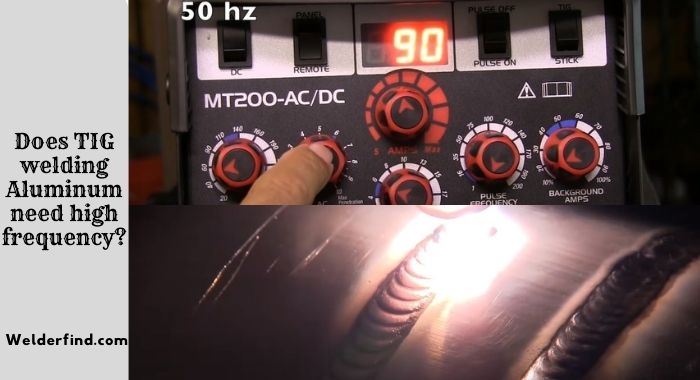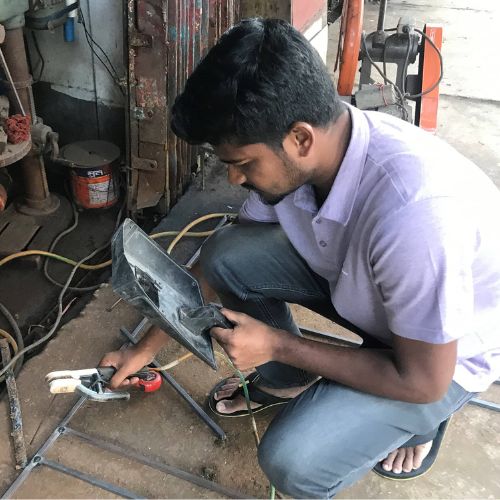Do you need a high-frequency to TIG weld aluminum? Beginner welders often forget to utilize high-frequency while TIG welding aluminum. Therefore, AC loses most of its half cycles during the alteration of the current flow.
This ultimately results in the machine stalling at low amperages. So, it is wise to use a high-frequency to TIG weld aluminum. However, one can also TIG weld Aluminum without high frequency.
Utilizing the high-frequency is crucial for successful aluminum welding. It helps to start and maintain the arc during the welding period. Moreover, aluminum exhibits a high oxide development rate. A high-frequency arc helps to break these layers for a better output.
Go through the entire article to learn more about the use of high-frequency in TIG welding aluminum. So, let’s start.
What does high-frequency do for TIG?
Utilization of high-frequency in TIG or Tungsten Inert Gas welding does multiple jobs. Here are some of the most significant ones:
Starting the arc
A high-frequency helps to develop the arc between the workpiece and the non-consumable tungsten electrode.
Maintenance of the arc
Once the arc is properly developed, then the high frequency helps to maintain the stability of the arc. The controlled arc is one of the keys to high-quality welds.
Shaping of AC waveform
The high-frequency element contributes to generating the AC waveform in AC TIG welding. It facilitates the transformation from EN to EP in order to generate a more seamless and regulated welding procedure.
Cleaning action
High frequency facilitates the removal of contaminants from the metal being welded. It can remove dirt, oil, and oxides from the surface of the metals. This cleaning process helps to generate a clean-look weld.
Penetration control
A high-frequency offers more sophisticated control over the depth of penetration during welding. Welders can more precisely control the weld bead’s form and accessing characteristics by altering the high-frequency settings. Therefore, it becomes easier for the welder to bring out the desired outcome.
Does TIG welding Aluminum need high frequency?

Frequency plays a vital role in TIG welding aluminum. The frequency ranges between 120 and 200 Hz for TIG welding aluminum. The utilization of high-frequency generates a better welding result. However, it is also possible to weld Aluminum without high frequency. But it is always easy and wise to utilize high-frequency. Here are some of the crucial reasons why TIG welding Aluminum needs high-frequency:
High-frequency electric power transforms into thermal energy during TIG welding aluminum. The thermal energy helps to produce high pressure on the aluminum workpiece to smoothly melt it. Otherwise, a lack of sufficient pressure makes aluminum welding extremely difficult.
Aluminum produces oxide layers at a fast pace. Therefore, it becomes harder to dig deeper. High-frequency welding breaks down the oxide layers for better penetration. It ultimately helps to create precise welding.
A high frequency helps to develop the arc between the aluminum workpiece and the tungsten electrode. Besides, it helps to maintain the arc throughout the welding process. Moreover, it also eliminates the arc blow issues.
A high-frequency helps to weld aluminum at different angles such as root passes, fillet welds, laps and joints.
Applications of TIG Welding Aluminum with High-frequency
TIG Welding Aluminum with High-frequency has several applications. Some of the key applications are as follows:
- Professionals use High-frequency for welding delicate Aluminum pieces. For instance, aluminum tubes, sheets and other components. The high frequency consistently maintains the arc to prevent any distortion and to reduce the risk of burn.
- In the automotive industry, professionals use high frequency for fabricating and repairing aluminum parts. These include car bodies, fuel tanks, exhaust systems, etc.
- Pressure vehicles such as cylinders and tanks have widespread use for industrial applications. Therefore, Pressure vehicles are one of the most prominent fields for TIG welding Aluminum with high frequency. HF produces high-quality welds with minimal defects.
- Aluminum is one of the most crucial components for the Aerospace industry due to its lightweight and rigid characteristics. Professionals commonly employ TIG welding with HF to attach critical aerospace components.
- TIG welding aluminum with high frequency is mostly common in the electronics industry for joining aluminum components. It is easier to control the arc with high-frequency to ensure even heat distribution.
How to TIG Welding Aluminum with High Frequency?
From the above-mentioned sections, it is evident that high-frequency is vital for TIG Welding Aluminum. How to TIG Welding Aluminum With High-Frequency? Here is the step-by-step guideline:
1.Prepare the materials
- Thoroughly clean the aluminum piece and remove the dirt and grease.
- Set up the TIG welding machine:
- Put on personal protection equipment
- Choose the appropriate tungsten electrode and install it in the TIG torch. Make sure the electrode is in the proper place and has sufficient tightness.
- Precisely secure the connection on the TIG torch cable and hose.
- Make sure the machine offers a sufficient cooling system
- Open the valve of the shielding gas bottle and ensure proper flow of the shielding gas. Depending on the thickness of your aluminum piece, One can use 25% Helium or 50 %Helium based on the aluminum pieces’ thickness.
- Frequency differs depending on the thickness of the aluminum pieces. Some TIG machines come up with automatic AC settings. Therefore, choose the welding machine based on your welding materials.
If you work on a thinner aluminum piece, then choose a high frequency. If your aluminum piece is thicker, a low frequency would better work.
2.Start with a baseline frequency:
The standard frequency for TIG welding aluminum ranges between 120 and 200 Hz for TIG welding aluminum. If you have any confusion regarding the frequency or thickness of the aluminum pieces, it is better to maintain the frequency from 70 to 100 Hz range. It will offer balanced heat generation and arc maintenance.
3.Make adjustments
Once the arc is properly developed, make the necessary adjustments. If you want a thin bead with improved arc control, set the frequency to 120 Hz or above. In contrast, if you want a wide bead with higher heat input, go for a lower frequency, like 60 Hz.
However, these are some basic guidelines. Always remember, TIG welding machines differ from one another. Furthermore, the frequency choice depends on the materials and your desired outcomes. So, only practice and experiment will help you to master the task.
Differences between TIG welding aluminum with and without high-frequency
There are significant differences between high and low frequencies. Let’s explore some of the major differences between these two:
| Differences | With High-Frequency (AC) | Without High-frequency(DC) |
| Smoothness | Smoothest welding result | Will not produce as smooth welding as high-frequency does. |
| spatter | High-quality spatter | Compromised spatter |
| Cost | It is more expensive than low frequency | It is comparatively less costly |
| Handling | It is comparatively difficult to handle | It is easier to handle |
| Reliability | It is less reliable | It is more reliable than high-frequency |
| Blow fixing | It can fix the arc blow-related issues | It can not fix arc blow problems |
Can You TIG welding Aluminum without high-frequency?
Even though high-frequency is more appropriate for TIG welding aluminum, it is also possible to TIG weld Aluminum without high-frequency. But many people don’t know how to TIG weld aluminum with low frequency.
TIG welding aluminum with low frequency is employed to generate wide beads and to ensure higher heat input during the welding process. However, the use of low frequency will have some limitations. For instance, it will be comparatively difficult to weld thick aluminum pieces. Besides, it will prolong the welding time duration.
However, some tips can make your task easier. Some major tips to TIG weld Aluminum without HF include:
- Choose the appropriate rod size. Most of the time, beginners prefer to work with smaller rods that melt before the completion of the welding process.
- Never use carbon steel brush in TIG welding aluminum. Instead, go for a stainless steel brush
- Avoid using high torching to quickly melt the filler metal.
- Avoid excessive torching in the corners
- Pure tungsten is very tempting. Therefore, never use pure tungsten while welding aluminum.
Final verdict
Many people, especially beginners ignore the importance of high-frequency in TIG welding aluminum, leading to undesirable welding outcomes. Do you need a high-frequency to TIG weld aluminum? It is highly recommended to use high-frequency during welding aluminum. But in some conditions, people can also use low frequencies.
In this article, I have gone through a detailed frequency-related issue. I hope the readers will find the information helpful in generating precise welding

Hello just wanted to give you a quick heads up.
The text in your post seem to be running off
the screen in Safari. I’m not sure if this is a formatting issue or something
to do with web browser compatibility but I figured I’d post to let you
know. The style and design look great though! Hope you get the issue resolved soon. Cheers
I will check and try to resolve the issue.
Thanks for your support.
Somebody necessarily help to make severely posts I’d state.
That is the very first time I frequented your web page and so far?
I surprised with the research you made to create this particular put up extraordinary.
Magnificent process!